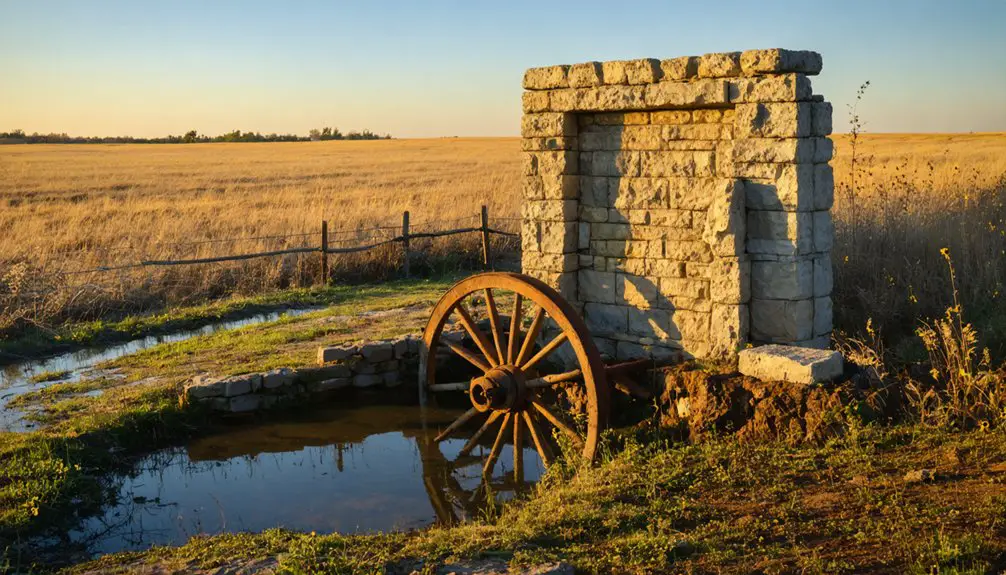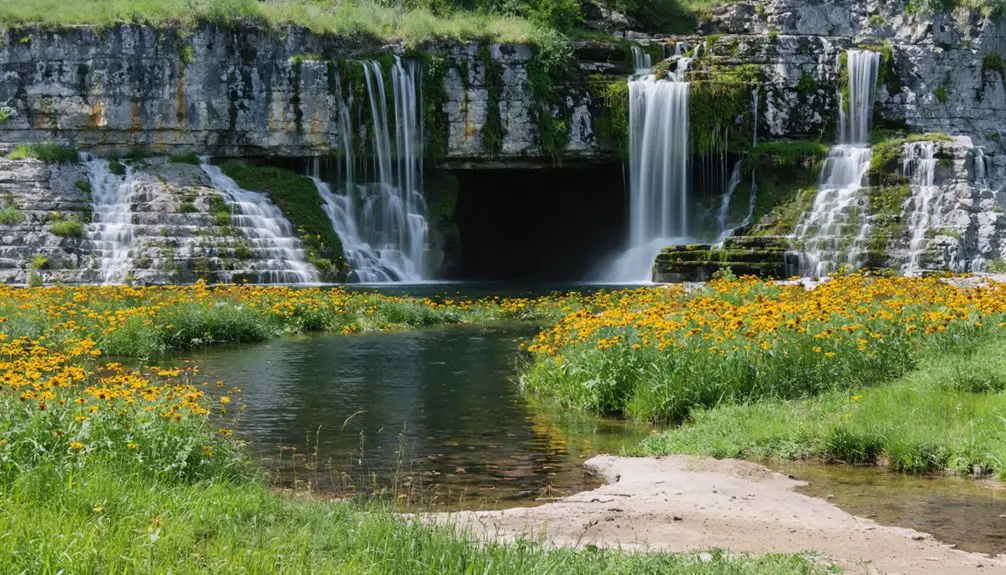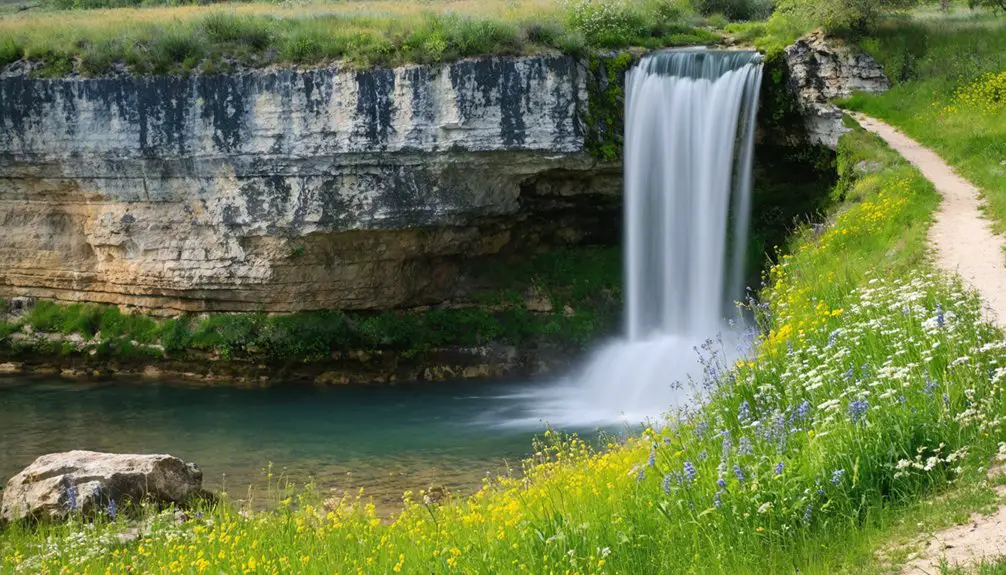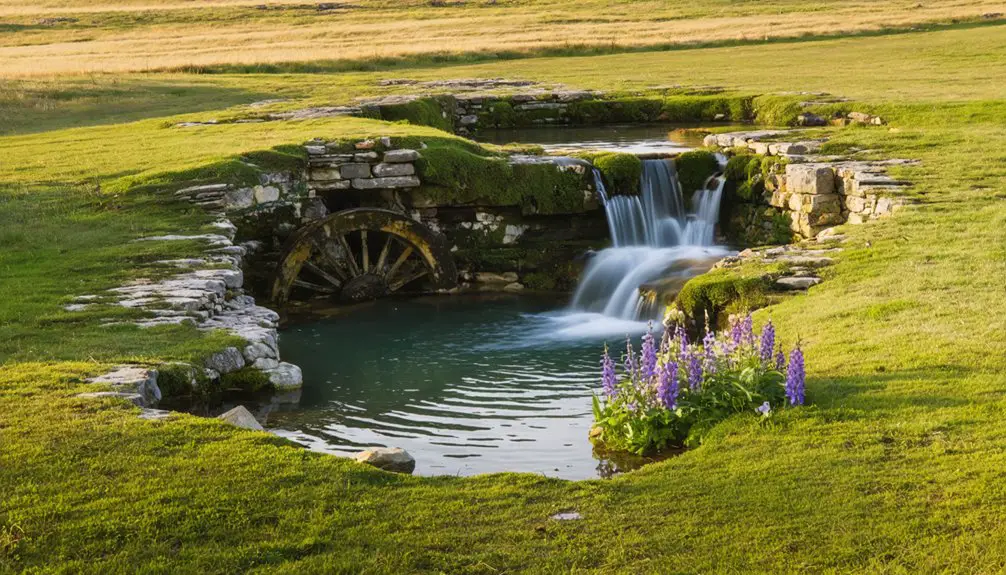You’ll find Alcove Springs nestled in Marshall County, Kansas, where a dramatic 10-foot limestone waterfall marks an essential rest stop along the Oregon Trail. Between 1840-1860, hundreds of pioneers stopped here daily to gather water and rest their wagon trains. The site’s most famous visitors were the ill-fated Donner Party, who carved their names into the rocks. Today, this ghost town’s preserved trails and pioneer inscriptions tell haunting tales of America’s westward migration.
Key Takeaways
- Alcove Springs transformed from a vital Oregon Trail rest stop to a ghost town after railroads replaced wagon trails as primary transportation.
- The town’s population declined significantly to just 86 residents by 2020, marking its status as a near-abandoned settlement.
- Historic markers and preserved wagon swales remain as evidence of the site’s former importance during westward migration.
- The location features a natural spring with a 10-foot waterfall, which originally attracted pioneers and remains a key historical landmark.
- The site now functions primarily as a heritage tourism destination, preserving pioneer inscriptions and trail history for visitors.
The Natural Wonder of the Limestone Spring
While many natural springs dot the Kansas landscape, Alcove Springs stands apart with its dramatic limestone formation and cascading waterfall.
You’ll discover a natural masterpiece where water flows over resistant Permian limestone layers, creating a ten-foot waterfall that plunges into a crystal-clear basin. The limestone formations, marked by distinctive chert inclusions, shelter a hidden alcove behind the falls. Early travelers like Edward Bryant praised the spring’s icy purity.
During spring months, you’ll witness the waterfall’s full glory as it fills the 15-by-10-foot basin below. Located in the Glaciated Region of northeastern Kansas, this spring served as a crucial water source for pioneers traveling the Oregon Trail.
Spring breathes life into Alcove’s cascading waters, creating a spectacular display as the falls fill their natural limestone basin.
The spring’s unique ecology thrives in this limestone-filtered environment, supporting native prairie vegetation and diverse wildlife. The pure, cold water that emerges from this geological wonder has carved out a natural sanctuary that’s captivated visitors since pioneer days.
Pioneer Life Along the Oregon Trail
The limestone springs at Alcove became an essential rest stop for the hundreds of thousands of pioneers who braved the Oregon Trail between 1840 and 1860.
You’d find wagon trains of up to 500 people stopping here to refresh their water supplies, tend to the sick, and gather strength for the challenges ahead. Wagon constitutions set strict rules for behavior and security during these stops.
Life on the trail tested even the strongest pioneers. These pioneers came from diverse cultures, settling the American West with varied backgrounds and experiences.
You’d face deadly diseases like cholera and smallpox, while thunderstorms and tornadoes could strike without warning. Nearly one in ten travelers didn’t survive the 2,170-mile journey.
Pioneer hardships included food shortages when hunting failed or supplies spoiled. Migration challenges forced travelers to band together in companies, sharing resources and expertise to overcome the untamed terrain.
For many, Alcove Springs offered a brief but essential refuge from these daily struggles.
The Donner Party’s Legacy
You’ll find the tragic story of the Donner Party’s westward migration preserved in the countless inscriptions pioneers left behind at key campsites like Alcove Springs.
The party’s stopover at this natural waypoint marked one of their final peaceful moments before taking the ill-fated Hastings Cutoff that led to their devastating winter in the Sierra Nevada. The group of 87 members had steadily grown from their initial departure from Springfield, Illinois as they joined with other families seeking opportunities in the West. The travelers were inspired by Lansford Hastings’ guidebook which promised a faster route to California.
These carved messages in the rocks near the springs serve as silent witnesses to both the hopeful beginning and eventual disaster of their journey, connecting modern visitors to one of America’s most infamous pioneer tragedies.
Tragic Camping Stop
Located along a stretch of the Oregon Trail near Independence Crossing, Alcove Springs served as a crucial camping spot for the ill-fated Donner Party in 1846.
The location’s cold, pure spring water, falling over a limestone ledge into a natural basin, provided much-needed sustenance for weary travelers and their livestock.
Tragic memories of this site endure through the death of Sarah Keyes, who succumbed to consumption while the party waited to cross the Big Blue River.
You’ll find their enduring resilience marked in the limestone cliff where they carved “Alcove Springs” – a memorial still partially visible today.
Though the exact burial site of Keyes remains unknown, a D.A.R. marker commemorates her passing at this significant stop along their westward journey.
This historic site, encompassing 714 acres of land, preserves both natural features and wagon swales from the Oregon Trail era.
After being closed for decades, the site reopened to visitors in the 1990s following a long period of vandalism concerns.
Lasting Historic Inscriptions
Carved into limestone rock faces at Alcove Springs, enduring inscriptions from the Donner Party stand as silent witnesses to their fateful 1846 journey.
You’ll find “Alcove Springs” spelled out in bold eight-inch letters, a reflection of early pioneer inscription styles. James F. Reed’s initials and the date “26 May 1846” remain clearly visible, marking the party’s brief stay before their tragic westward trek.
The historical significance of these carvings extends beyond mere graffiti. They’re part of a larger tradition of trail markings left by westward pioneers, including famous scouts like John C. Fremont and Kit Carson. The natural beauty of the area’s twelve-foot waterfall provided welcome relief for weary travelers. The group waited here for five difficult days while water levels remained too high to cross the Big Blue River.
Though weathered by time, these rock-carved messages continue telling stories of determination and sacrifice. Near these inscriptions lies the unmarked grave of “Grandma Keyes,” adding a poignant human element to this historic site.
Historical Landmarks and Rock Carvings
You’ll find pioneer names and messages etched into the limestone cliffs at Alcove Springs, where the Donner Party famously carved the site’s name during their ill-fated journey west.
The natural limestone formations create an ideal canvas for these historical inscriptions, with the harder rock layers protecting softer deposits beneath.
Local preservation efforts focus on protecting these rare trail markers from erosion and vandalism while maintaining their authenticity as direct connections to 19th-century western migration.
Pioneer Names Etched Forever
Among the most compelling features at Alcove Springs are the countless names and initials etched into the surrounding rocks by 19th-century pioneers who stopped here during their westward journey.
You’ll find James F. Reed’s initials from May 1846, carved just before the Donner Party’s fateful delay at the flooded Big Blue River. These pioneer inscriptions tell stories of diverse travelers – from gold seekers to Mormon emigrants – who paused at this crucial waypoint.
The historical significance of these carvings can’t be overstated. They’re authentic markers of America’s westward expansion, with many still visible today.
The top alcove rocks display some of the earliest markings, including the very inscription that gave the spring its name. Modern archaeological studies continue to reveal new insights about the site’s role in pioneer history.
Natural Rock Formation Details
While pioneer inscriptions tell their human stories, the natural limestone formation itself stands as a tribute to geological forces that created this essential waypoint.
You’ll find a hard, resistant Permian limestone ledge overlooking softer shale layers, where spring water cascades 10-12 feet into a shallow basin. This natural alcove measures roughly 15 feet long, 10 feet wide, and 3-4 feet deep.
The limestone’s durability has preserved the site’s geological significance, creating a reliable water source that proved vital for westward travelers.
The rock formation’s natural shelter made it an ideal resting spot along the Oregon and California trails. Today, the spring still flows seasonally, primarily during spring months, maintaining its character much as pioneers would have experienced it.
Trail Marker Preservation Methods
Preserving trail markers and historical landmarks at Alcove Springs requires careful coordination between government agencies, local organizations, and dedicated volunteers.
You’ll find various marker maintenance techniques in place to protect these precious remnants of history, ensuring they’ll be here for future generations to discover.
- Local historical societies partner with government agencies to maintain protective barriers around sensitive areas.
- Community volunteer groups conduct regular assessments of marker conditions and site integrity.
- Preservation techniques follow strict federal and state guidelines to maintain historic authenticity.
- Funding comes through a mix of government grants, private donations, and matching programs.
As you explore the site, you’ll notice these preservation efforts help maintain the original character of the landmarks while protecting them from environmental damage and human impact.
The markers serve as essential connections to the area’s rich pioneer heritage.
Role as a Vital Water Source
During the mid-19th century westward migration, Alcove Springs emerged as one of the most critical water sources along the Oregon and California Trails.
Nestled along the Oregon and California Trails, Alcove Springs became a lifeline for countless pioneers during America’s great westward migration.
You’ll find this natural spring cascading 10-12 feet over limestone ledges into a crystal-clear pool, offering pure, cold water that proved essential for survival.
As you follow the trail west from the Missouri River crossing at Westport, you’ll discover why this spring’s water source significance can’t be overstated.
It was often the first reliable water stop emigrants encountered, positioned perfectly near Independence Crossing.
The spring’s seasonal flow patterns matched the migratory patterns of countless wagon trains, including the ill-fated Donner Party and Mormon pioneers.
While the spring’s waters couldn’t sustain permanent settlement, they kept countless travelers alive on their journey west.
From Bustling Stop to Ghost Town

You’ll find Alcove Springs’ transformation from bustling trail stop to ghost town reflected in its shuttered post office and dwindling population of just 86 residents by 2020.
The town’s liveliness faded as transportation shifted from wagon trails to railroads and highways, leaving this once-essential rest stop isolated from major routes.
What remains today is primarily preserved for heritage tourism, with historic markers and interpretive signs telling the story of its Oregon Trail significance rather than supporting an active community.
Travelers’ Final Rest Stop
Located near Independence Crossing along the Big Blue River, Alcove Springs emerged as an important waypoint for countless pioneers traversing the Oregon Trail.
You’ll find a reflection of migration challenges in the spring’s pure, cold water cascading over rock ledges, providing essential refreshment for both travelers and their animals during grueling rest stop experiences.
- John C. Fremont’s 1842 expedition and Marcus Whitman’s 1843 group chose this spot for respite
- The Donner Party marked their passage here, with Sarah H. Keyes’ burial nearby
- Pioneer carvings remain etched in surrounding rocks, preserving their stories
- Natural meadows offered significant grazing for oxen and horses during extended stops
The site’s historical significance lives on through these physical remnants, telling tales of determination, hardship, and the pursuit of western dreams.
Trail Town’s Quiet Transformation
While pioneers once flocked to Alcove Springs as an essential waypoint on their westward journey, the bustling trail stop gradually faded into quiet obscurity as transportation patterns shifted in the late 1800s.
The arrival of railroads diverted wagon traffic elsewhere, triggering an economic decline that prevented the site from developing into a permanent settlement. You’ll find that nearby towns like Blue Rapids drew away potential growth, leaving Alcove Springs to evolve from a crucial rest stop to a silent witness of the past.
Today, the land has reclaimed much of what pioneers once used, with wagon swales and historic carvings preserved as touchstones of cultural memory. The site’s transformation from practical waypoint to heritage park reflects the broader story of America’s vanishing frontier trails.
Preserving Trail History Today
Through dedicated preservation efforts since 1992, Alcove Springs has transformed from an endangered historic site into a protected landmark that continues telling the story of America’s westward migration.
You’ll find trail preservation groups working tirelessly to maintain wagon swales, historic inscriptions, and the iconic limestone spring that drew countless pioneers westward.
Community involvement through organizations like OCTA and the Alcove Spring Preservation Association guarantees this essential piece of heritage stays intact for future generations.
- Trail maintenance teams protect visible wagon ruts and control vegetation growth
- Educational programs and guided tours connect visitors with emigrant stories
- Regular monitoring preserves historic carvings, including Donner Party inscriptions
- Digital resources and partnerships expand awareness beyond physical site visits
Native Flora and Geological Features

Limestone cliffs and native tallgrass prairie create a unique ecological setting at Alcove Springs, where a natural spring emerges from ancient Permian rock layers.
You’ll find a stunning 10-foot waterfall cascading over weather-worn limestone into a crystal-clear pool below, carved by centuries of flowing water and erosion of the softer shale beneath.
Native grasses like bluestem and switchgrass dominate the surrounding prairie, while riparian vegetation thrives along the Big Blue River’s edge.
Willows and cottonwoods line the waterways, their roots anchored in the moist soil.
Seasonal wildflowers dot the meadows, and mosses blanket the limestone boulders near the spring.
This remarkable blend of geology and flora continues to tell the story of Kansas’s natural heritage, just as it did when pioneers first discovered this oasis.
Impact on Westward Migration
As pioneers ventured westward from Missouri in the 1840s, Alcove Springs emerged as an essential landmark on the Oregon Trail, offering weary travelers their first major rest stop after leaving Westport.
You’ll find this landmark’s importance deeply woven into pioneer migration history, where it served as both a lifeline and navigation point for countless wagon trains.
- The spring’s pure, cold water helped prevent dehydration among emigrants tackling the challenging prairie terrain.
- Its location near Independence Crossing of the Big Blue River made it a critical decision point for route selection.
- You can still see pioneer inscriptions carved into the rocks, evidence of those who passed through.
- The site gained further historical significance as the burial place of Sarah Keyes, the Donner Party’s first casualty.
Modern Heritage Tourism Site

Today, Alcove Springs stands as a protected heritage destination, recognized by both the National Park Service and the National Register of Historic Places.
Safeguarded for future generations, Alcove Springs preserves a vital piece of American pioneer history under federal protection.
You’ll find this 714-acre site just four miles north of Blue Rapids, Kansas, where heritage preservation efforts maintain the natural spring, historic wagon swales, and weathered pioneer inscriptions carved into limestone cliffs.
While tourism challenges include minimal infrastructure, that’s precisely what keeps the site’s authenticity intact.
You can explore the interpretive shelter, walk the trails, and connect with pioneer history through educational displays.
The site serves as an outdoor classroom where you’ll discover stories of westward migration, including the Donner Party’s passage.
Local communities still gather here for commemorative events, keeping the spirit of the Oregon Trail alive through low-impact heritage tourism.
Frequently Asked Questions
Are There Camping Facilities Available at Alcove Springs Today?
You won’t find camping facilities directly at the site due to camping regulations protecting its historic features. However, you’ll discover tent sites at Oak Springs Campground, just 6 miles away.
What Is the Best Time of Year to Visit Alcove Springs?
Like nature’s grand performance, you’ll want to visit in spring (March-April) when seasonal attractions peak with flowing waterfalls, comfortable hiking weather, and prime photography opportunities of both historical features and natural scenery.
How Long Does It Take to Walk the Entire Historical Site?
You’ll need about an hour to explore at a comfortable walking pace, though you can spend up to two hours if you’re keen on absorbing the historical significance at every interpretive stop.
Are There Guided Tours Available at Alcove Springs?
Like the pioneers who charted their own path west, you’ll need to self-guide your exploration. There aren’t regular guided tours available, but interpretive exhibits help you discover the site’s historical significance independently.
Can Visitors Collect Artifacts or Rocks From the Site?
No, you can’t collect artifacts or rocks. It’s illegal and damages artifact preservation efforts. The site’s historical significance requires leaving everything untouched so future visitors can experience this important heritage site.
References
- https://www.legendsofamerica.com/alcove-spring/
- https://legendsofkansas.com/kansas-ghost-town-list/
- https://en.wikipedia.org/wiki/Alcove_Springs
- http://bigdaddydavesbitsandpieces.blogspot.com/2015/08/off-beaten-path-east-central-kansas.html
- https://kansassampler.org/8wondersofkansas-geography/alcove-spring-near-blue-rapids
- https://kgs.ku.edu/kansas-springs
- https://geokansas.ku.edu/alcove-spring
- https://www.hou.usra.edu/meetings/lpsc2014/eposter/1027.pdf
- https://octa-trails.org/wp-content/uploads/2023/05/Vore-and-Nickel-GEOPHYSICAL-INVESTIGATIONS-OF-FOUR-SUSPECTED-PIONE.pdf
- https://www.blm.gov/sites/default/files/learn_interp_nhotic_historybasics.pdf



